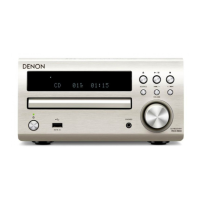NOTES ON HANDLING AND REPLACEMENT OF THE LASER PICK-UP
1. Protection of the LD
Solder a part of the LD circuit to short-circuit. After connecting the circuit, remove the soldering form. Precautions when
handling the laser CD mechanism.
2. Precautions when handling the laser CD mechanism
• Be careful not to expose the laser pick-up to dust.
• Do not leave the laser pick-up bare. Be sure to cover it.
• If dust adheres on the laser pick-up lens, blow it off with a blower brush.
• Do not apply shock to the laser pick-up.
• Do not watch the light of the laser pick-up.
3. Cautions on assembling and adjustment
• Be sure that the bench, jig, head of soldering iron (with ceramic) and measuring instruments are well grounded.
• Workers who handle the laser pick-up must be grounded.
• The nished mechanism (prior to anchoring in the set) should be protected against static electricity and dust.
The mechanism must be stored where abnormal external force is not applied.
• When carrying the nished mechanism, hold it by the chassis body.
• Do not use or store the mechanism where corrosive gas such as H2S, SO2, NO2 and CI2 or toxic gas may be generat-
ed, or where substances especially organosilicon, cyanide, formalin and phenolic materials exist. In particular, make
sure that these substances which generate toxic gas do not exist in the set. This may cause the motor not rotating.
4. Determining whether the laser pick-up is defective
Cannot read discs, unsteady playback, etc.
Measure the RFO waveform of the MCU CD PCB and check the amplitude level.
(page 37
② Measuring the RFO Waveform
)
Between 0.4 and 1.1 (Vp-p)
Check the laser drive current (Iop)
(See "4.7 Displaying the laser current" in "4. CD test mode" for instructions on checking this.)
The present value is 1.5 times the default.
Replace the Traverse Unit
Store the laser current after replacement
Protective soldering place for laser diode.
NO
17

